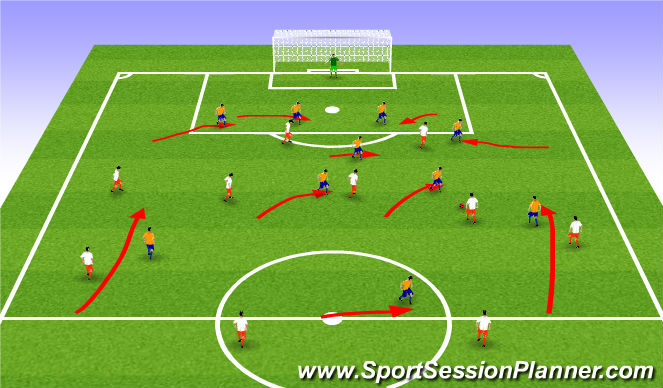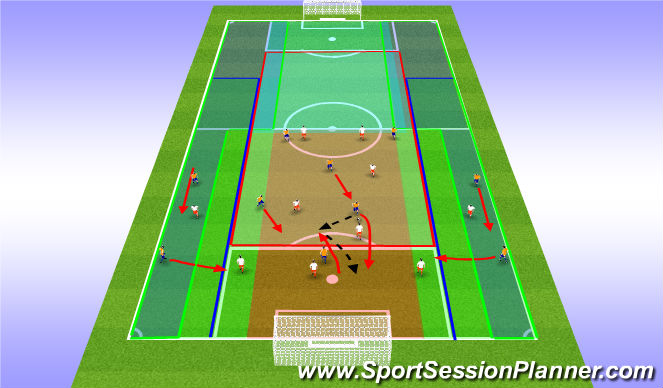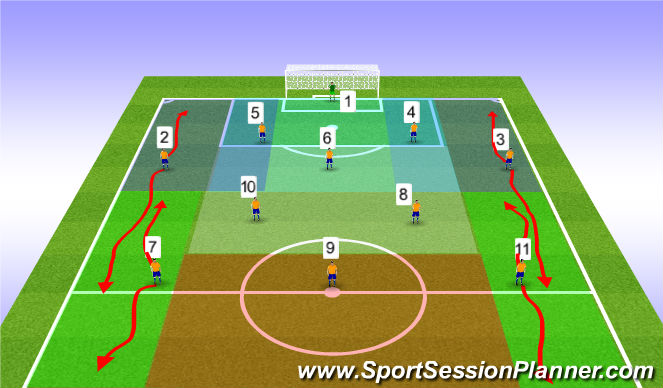Football/Soccer Session (Advanced): 4:3:3 System
Profile Summary

| Name: | Frank Greenawalt |
|---|---|
| City: | Riverside |
| Country: | United States of America |
| Membership: | Adult Member |
| Sport: | Football/Soccer |

See the guidance at the top of this page to understand why you are not seeing interactive Football/Soccer images.

4:3:3 in Defense
General Defensive Concepts
Pressure must be applied to the ball before defense can begin. Until there is pressure on the ball the
team must drop towards their own goal/18. When pressure is applied the team then can step and compress space.
Coaching Points:
+ Pressure must be immediate.
+ Pressure must force that attacker’s vision down.
+ Pressure must make play predictable.
+ Pressure must prevent passing penetration.
Pressure must be accompanied by immediate cover. Covering players are responsible for filling space
behind the pressure to eliminate the threat of dribble penetration. Quality defending requires a team to get numbers up around the ball everywhere on the field. The team defends together. When pressure is applied, the entire team must step together to stay compact. Space can not exist between lines on the field, or between pressuring players and the rest of the team. The team must also shift across the field together as the ball moves. In general, the team must move as one unified block whenever the ball moves. This puts high demands on work rate and coordination. The team must step and compress space every time the ball moves backwards. On both their own clearances and on any backpasses played by the opposition the team must step to recover space and to eliminate time the opposition has to make decisions.
Defense Play of the Back Four: Combination Man/Zone:
Defending in a 4:3:3 should be done primarily with zonal defending. Players are not solely responsible for marking an individual opponent but instead are responsible for filling areas of space and marking any opponents in those spaces. Zonal defending allows the team to keep a better defensive shape, and
reduces some of the physical demands of man-marking. Because the 4:3:3 does not have outside midfielders, the back four must not play with a sweeper-stopper system. Instead, the two center backs are always staggered depending on where the ball is. If the ball is on the left, the right center back is deeper than the left center back. Playing with 2 centerbacks will allow the outside backs to step into wide spaces more effectively defensively to address the weakness within the system. Inside the penalty box, the system switches to purely man-to-man marking. Proximity to the goal does not allow for space to zone.
Defensive Play of the Midfield Three:
The midfield three will also function under zonal principles, however, this group must be much more aggressive and attack the ball on defense. The work rate of the three midfield players is going to determine if this system works. These three players are primarily responsible for the middle vertical third of the field—the area between the sides of the penalty boxes. Wide space must normally be covered by outside backs and wingers. The outside midfielders will be pinched in, so that the midfield works as a tight triangle wherever they go on the field. If the outside midfielders get stretched too wide, the team will get beaten up that middle, as the central midfielder will constantly be numbers down defensively. In the attacking and midfield thirds of the field, this group should force the ball centrally, where the team will have numbers up most of the time. Forcing the ball inside will reduce space for attackers to play in, and is uncomfortable for most outside backs. Also, turnovers in this area create natural counter-attack opportunities. One player must always be in the “hole” in front of the center backs. This player is most important to prevent counters up the middle of the field, and to “protect” the center backs. This player acts partially as a screen, preventing balls in to the feet of center forwards.
Coordination Between the Backs and Midfield:
The inherent defensive weakness in the 4:3:3 is the lack of outside midfielders. If this outside midfield space is not defending appropriately, the team will have major difficulties. Because, the

See the guidance at the top of this page to understand why you are not seeing interactive Football/Soccer images.

4:3:3 in Attack
4:3:3 General Attacking Concepts:
Attacking width will come from the 3 forwards and the outside backs. The midfield triangle will primarily remain in the center of the field to penetrate centrally, to distribute wide, and to prevent counter attacks.
The outside backs must be technically competent to attack space on the flanks, and must be tactically
aware of when and how to overlap into attack. These players should be considered credible weapons in buildup and in penetration. The midfield must play quickly wide or forward to relieve pressure. One attacking midfielder will be responsible for late runs into the box on wide services, while the deeper midfielders will be responsible for sealing space behind the ball. The center forward will always be responsible for attacking the near post on crosses. The weak side winger will be responsible for far post runs. Players coming from deeper on the field will fill all other spaces. The first option upon winning possession is always to one of the forward players—either a penetrating ball into space, or a ball forward to feet. The forward three should always be pushing the restraining line as far back as possible.
Starting Positions of the Forward Three:
When the ball is on the side: The ball side winger should always stretch the field as wide as possible. The center forward should stretch the field as high as possible. The weak side winger will pinch in 15 – 25 yards in order to create another threat behind the defense, and to give the center forward a teammate to play in combination with.
When the ball is central:
All forwards should push as high as possible, and the wingers should be as wide as possible, back to sideline. All players should look to make runs back to receive the ball at their feet, or diagonally to be played in behind.
Movement Options of the Front Three:
There should always be at least one run checking back to the ball. This run can come from the ball side
winger, the center forward, or both players. Other runs should occur in coordination with this run to use space created by defenders pulled out of position. A particularly dangerous run comes from the center midfielder recreating length by moving past the center forward when the center forward checks back to the ball. The most dangerous ball is always one played behind the defense, so one run should always look to attack or exploit this space.
When the wingers receive the ball wide:
When a winger receives a ball in a wide position, they must look to attack their defender with speed when possible. Several options will be available to combine with other forwards or to play through balls behind the defense. In the attacking third, the winger should be confident to beat his mark 1 v 1.








 Play animation
Play animation Play step-by-step
Play step-by-step Repeat (toggle)
Repeat (toggle) Full Screen
Full Screen Pause
Pause Stop
Stop
4:3:3 System
4:3:3 System
The 4:3:3 is an ideal system to learn because of its tactical flexibility. Minor adjustments in positioning and mentality easily allow the system to become a more defensive 4:5:1, or a more attacking 4:2:4. These adjustments are easier to make in the 4:3:3, than in most other systems.
Showing players the patterns of movement in a 4:3:3 on paper enhances their understanding of the system, and allows for quicker learning on the training field in functional training. Players that are familiar with the basic concepts of every line in the system, both in attack and defense, will be smarter and better prepared to make quick decisions during matches.